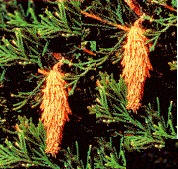|
 Bagworms and iron chlorosis Bagworms and iron chlorosis
 Send a link to a friend
Send a link to a friend
By John
Fulton
[June 05, 2007]
After some very severe infestations of
bagworms the past few years, the calls have been coming in all year
on the correct treatment times for bagworms this year. Year-in and
year-out, the correct treatment time for bagworms is June 15. You
can mark this date on your calendar for next year and be within a
few days of the correct treatment time. With a very cool spring, a
week later may be a possibility. The opposite is true for a very
warm spring. The idea is to have all the eggs hatched before
treatment but not wait until the bagworms are almost mature.
|
|
The next problem is what to use. The traditional standby
has been Sevin, but the Bt products such as Dipel and Thuricide
have really taken their share of the market the past several
years. The Bt products have several good points, including
safety to mammals and toxicity to larger bagworms. Since they
are bacteria that affect only the larvae of moths and
butterflies, it does take a while for the bacteria to build up
to the point where they can kill the bagworm. I won't get into
the discussion about monarch butterflies lighting in the tree
just after treatment (actually these products don't kill the
butterflies -- only the larvae would be killed). If you are in
doubt about whether you have bagworms, check your trees and
shrubs around June 15. You can actually see the small bags as
the larvae build them. They become very noticeable at about
one-sixteenth of an inch long. Treat bagworms early, since
larger ones are more difficult to control. The spring we have
had is probably going to zero out the timing, meaning the last
two weeks of June should be ideal.

Most people think that bagworms affect evergreens only. True,
that is their preferred host group, but bagworms have a huge
number of potential hosts. Through the years I have seen them on
oak trees, grapevines, apples and about any other growing thing
you can think of. Make sure to check the tops of tall trees. An
infestation may get started in a tall tree simply because you
can't reach the top when applying a control. In that case,
you'll have to use a taller ladder.
[to top of second column]
 |
 Iron chlorosis
It's that time of year when iron chlorosis has started to show up
again as the yellowing of leaves, with a darker green color
immediately around the veins in a leaf. This usually shows up on the
younger leaves first. This yellowing is particularly noticeable on
pin oaks and sweet gums but may be seen on other species.
The cause is the lack of available iron for the plant. Manganese
is another element that can cause these symptoms. There can be tons
of iron in the soil, but if the soil pH is not acid enough, the
plant cannot take the iron up. Possible solutions include altering
the soil pH with either nitrogen or sulfur (be careful since it may
take a truckload to alter the soil around a large tree), spraying
leaves every two to four weeks with a foliar iron compound, or
implanting iron tablets in the trunk, which would last from two to
four years.
Injury from iron chlorosis is the eventual decline of the plant,
and it may lead to plant death over a period of time. Also, don't
expect treatments to green leaves up immediately when applied now.
In fact, many times the implanted iron tablets don't show green
leaves until the following year when the sap begins to rise. Many
people have been using the iron tablets in the dormant period of the
tree and have had good results.
[Text from file received from
John
Fulton, University of Illinois Extension,
Logan County Unit] |